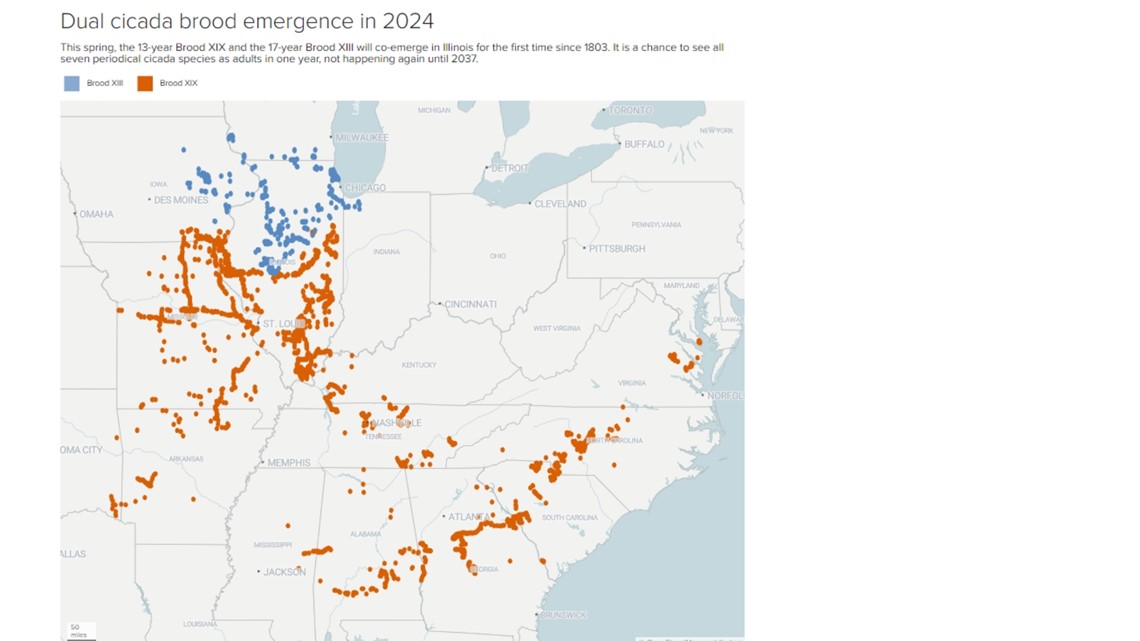ST. PETERSBURG, Fla. — Summer nights in Florida often have that familiar, loud buzz of cicadas filling the humid air. The insect's mating call varies in annoyance levels for human listeners, but the bugs don't seem to mind being an inconvenience.
By now, you've likely heard about two broods of cicadas about to surface across the United States, classified as Brood XIX and Brood XIII. They are two of the 15 broods of periodical cicadas located in the eastern and central U.S.
Brood XIX typically appears in the southern U.S. every 13 years while Brood XIII shows up mostly every 17 years in Illinois and its surrounding states. Cicada "broods" are groups of insects that always emerge at the same time and can be made up of different cicada species.
With Brood XIX happening in the southern U.S., you may be wondering: Is Florida going to get overrun with cicadas this year?
Will Florida see cicadas emerge in 2024?
The short answer — no. Florida is not going to be subject to the trillions of cicadas from either Brood XIX and Brood XIII in 2024. In fact, Florida won't see any brood of cicadas emerge.
The reason is simple: Those types of cicadas don't live in Florida. While there are multiple species of cicadas, they can be split up into two kinds — periodical and annual. Just like the names imply, some cicadas only show up at specific times and others appear every year.
Florida only has annual cicada species, according to the University of Florida's Institute of Food and Agriculture Sciences.
This means people in the Sunshine State can breathe a sigh of relief, knowing the "sound of summer" won't be completely taken over by the crooning bugs looking for love.
No, this isn't the first time since 1803 that two broods of cicadas emerged at once
You might have seen numerous social media posts claiming that 2024 will be the first time since 1803 that two groups of cicadas will emerge at the same time. Some of the posts have even referred to it as a “cicada apocalypse” because 1 trillion cicadas are expected to emerge at once.
However, our Verify team determined this isn't true. Rather, it happened just nine years ago in 2015. Typically, two broods of cicadas emerge together every five or six years but usually not in the same place.
It is true these specific broods — XIX and XIII — haven't emerged together since 1803, the phenomenon itself is fairly common.
The University of Connecticut Biodiversity Research Collections lists each of the 15 broods of periodical cicadas, their geographic range and the last four times each one emerged.
Two broods of cicadas emerged at once most recently in 2015, 2014, 2002, 2001, 1998 and 1985, according to the university.
“Generally, a 13-year brood emerges in the same year as a 17-year brood roughly every 5-6 years, though most of the 17-year broods are not in contact with a 13-year brood, so the different cicadas are clearly separated in space,” the University of Connecticut says.
Map: Where will cicadas be in 2024?
Trillions of periodical cicadas will emerge from the ground this spring, bringing with them their loud buzzing and molted exoskeletons. Here's where you will be able to see cicadas in the U.S.
The 13-year cicadas, called Brood XIX, will emerge in Georgia and the Southeast. The 17-year cicadas, called Brood XIII, will appear in Illinois. This will be the first time since 1803 that two broods emerged at the same time. The next time this happens will be 2037.
The overlap of these two broods has been dubbed by an expert as "cicada-geddon" – but it won't be the biggest cicada event. In 2076, the two largest broods –XIX and XIV – will come out together. "That is the cicada-palooza," University of Connecticut cicada expert John Cooley said.


A map from the U.S. Department of Agriculture shows the emergence of both the 13- and 17-year cicada broods from 2013 to 2029.


Reporting from TEGNA's Emery Winter, WLTX's Caitlin O'Kane and CBS News contributed to this article.

